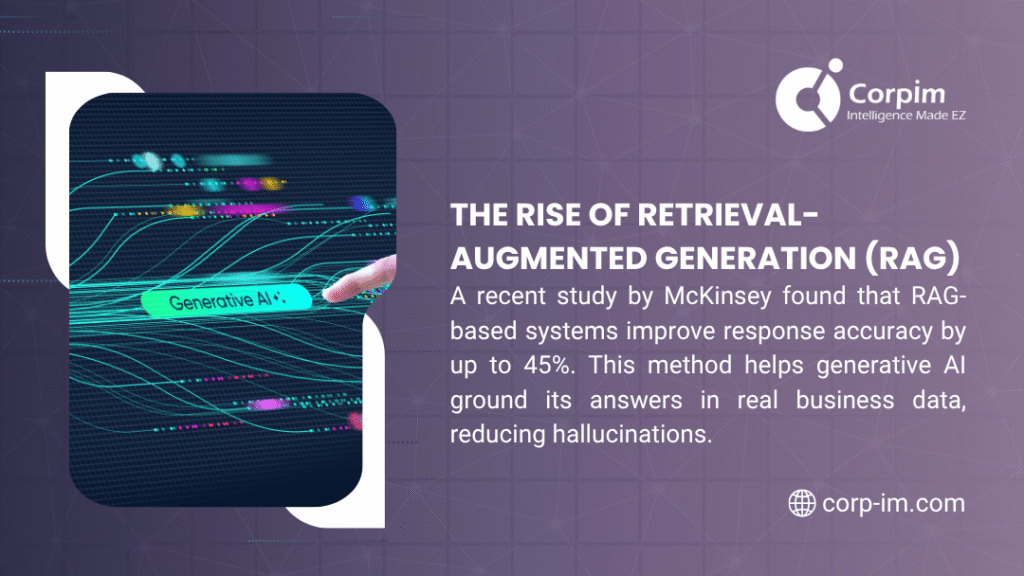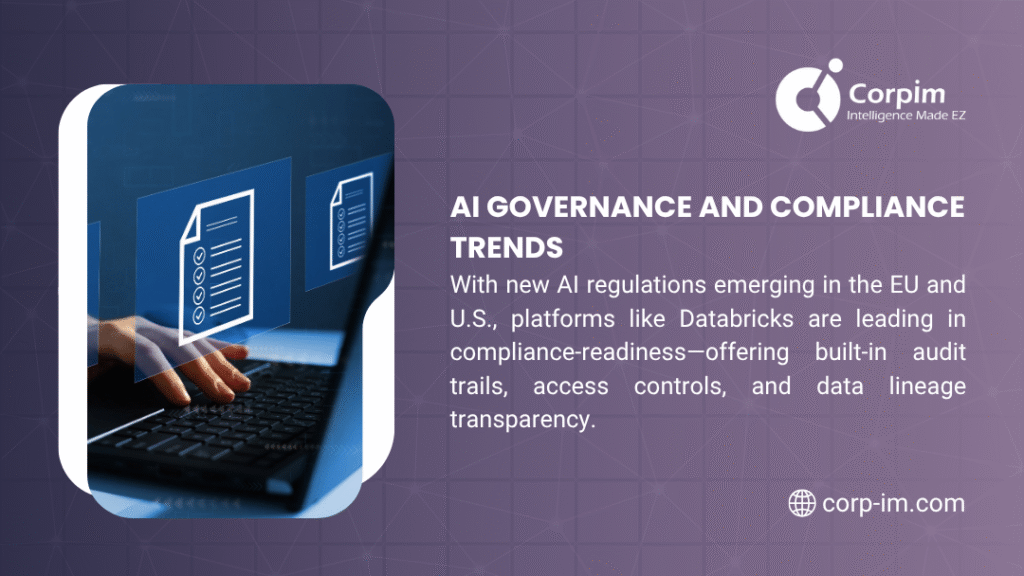Article Summary
Databricks Generative AI is revolutionising how organisations build and deploy artificial intelligence applications at scale. This comprehensive guide explores what Databricks Generative AI is, how it integrates with the lakehouse platform, and why enterprises are choosing it for their AI initiatives. You’ll discover the key features, step-by-step implementation process, real-world use cases across industries, and proven best practices for maximizing your AI investments. Whether you’re a data scientist, IT leader, or business stakeholder, this guide provides everything you need to understand and leverage Databricks for your generative AI projects.
What is Databricks Generative AI?
Databricks Generative AI is an integrated platform that enables organisations to build, deploy, and manage generative AI applications using large language models (LLMs) and other advanced AI technologies. It combines the power of the Databricks lakehouse architecture with purpose-built tools for developing AI solutions that can generate text, code, images, and other content.
Think of it as a complete workspace where your data, AI models, and applications live together. Instead of juggling multiple tools and platforms, Databricks brings everything under one roof, making it easier to turn your data into intelligent applications that can understand and generate human-like responses.
The platform addresses one of the biggest challenges in AI implementation: connecting your proprietary data with powerful AI models in a secure, scalable way. Most generative AI solutions rely on general knowledge, but businesses need AI that understands their specific products, customers, and operations. Databricks bridges this gap.
Why Databricks for Generative AI?
Traditional AI development requires piecing together various tools, managing complex infrastructure, and dealing with data silos. Databricks eliminates these headaches by providing a unified platform where your data warehouse and data lake merge into a lakehouse, giving AI models access to all your information without complex data movement.
Security and governance are built in from the ground up, ensuring your sensitive data remains protected whilst still powering AI applications. The platform offers scalability that grows with your needs, from experimentation to enterprise-wide deployment.
Understanding what is Databricks helps you grasp why this platform has become so popular for AI workloads. It’s designed specifically for the demands of modern data and AI applications.

Key Features of Databricks Generative AI
Databricks packs numerous capabilities into its generative AI offering. Here are the features that matter most:
Foundation Model APIs
Databricks provides direct access to leading foundation models through simple APIs. You can work with models from OpenAI, Anthropic, Cohere, and others without leaving the platform. This means no separate accounts, no credential juggling, and unified billing.
The platform also supports open-source models like Llama, MPT, and Falcon. You can compare different models, test which works best for your use case, and switch between them without rewriting your code.
Vector Search Capabilities
Generative AI applications often need to search through large amounts of unstructured data to find relevant context. Databricks Vector Search makes this possible by converting your documents, images, and other content into mathematical representations that AI models can quickly search through.
This technology powers retrieval-augmented generation (RAG), where the AI retrieves relevant information from your data before generating responses. The result is AI that provides accurate, contextually relevant answers based on your actual business information rather than generic knowledge.
MLflow Integration
MLflow is Databricks’ open-source platform for managing the machine learning lifecycle. For generative AI, this means you can track experiments, version your models, manage deployments, and monitor performance all in one place.
You can test different prompts, compare model outputs, track costs, and ensure your AI applications maintain quality over time. This level of organization becomes critical when you’re managing multiple AI projects across your organisation.
Model Serving Infrastructure
Building an AI model is one thing, but making it available to your applications reliably is another challenge entirely. Databricks Model Serving handles the complex infrastructure needed to run AI models at scale.
It automatically manages resources, scales based on demand, handles failures gracefully, and provides monitoring and logging. Your data science team can focus on improving models rather than managing servers.
Lakehouse Monitoring
AI models can drift over time, producing lower quality outputs as patterns in data change. Databricks Lakehouse Monitoring tracks your AI applications, alerting you to quality issues, performance degradation, or unexpected behaviour.
This proactive approach prevents problems from reaching your users and helps you maintain high-quality AI experiences consistently.
How Databricks Generative AI Works: Step-by-Step Process
Understanding the workflow helps you plan your implementation effectively. Here’s how organisations typically build generative AI applications on Databricks:
Step 1: Prepare Your Data Foundation
Everything starts with data. Generative AI models need context from your business to provide valuable outputs. This means collecting and organising your documents, customer interactions, product information, and other relevant content.
Databricks lakehouse architecture simplifies this process. You can store structured data (like customer databases), semi-structured data (like JSON logs), and unstructured data (like PDFs and images) all in one place. The platform handles the technical complexities of managing these different data types.
Implementing proper data pipeline architecture best practices ensures your data flows smoothly from source systems into your lakehouse, keeping your AI applications fed with fresh, accurate information.
Step 2: Choose and Configure Your Models
Next, select which AI models you’ll use. Databricks provides access to various options, each with different strengths:
Large general-purpose models like GPT-4 excel at diverse tasks but cost more per request. Specialised models like Cohere’s command models work well for specific use cases at lower cost. Open-source models give you full control and no per-token charges but require more technical expertise to tune and deploy.
You can start with proprietary models for quick results, then potentially move to fine-tuned open-source models as your use case matures. Databricks makes switching between models straightforward, so you’re never locked into one approach.
Step 3: Implement Vector Search and RAG
For most business applications, you’ll want to implement retrieval-augmented generation. This technique dramatically improves accuracy by grounding AI responses in your actual data.
The process works like this: First, you convert your documents into vector embeddings using the platform’s vector search capabilities. When a user asks a question, the system searches these vectors to find the most relevant information. That context is then provided to the AI model along with the question. The model generates a response based on both its training and your specific data.
This approach prevents the AI from making up information (a problem called hallucination) and ensures responses reflect your current business reality.
Step 4: Develop Your Application
With your data prepared and models configured, you can build the actual application. Databricks notebooks provide an interactive environment for development, supporting Python, SQL, R, and Scala.
You might create a customer service chatbot, an automated document analysis system, a code generation tool for developers, or countless other applications. The platform provides libraries and frameworks that simplify common tasks like prompt engineering, output formatting, and error handling.
How AI is transforming business intelligence demonstrates the breadth of applications possible when combining generative AI with business data.
Step 5: Test and Refine
Before deploying to users, thorough testing ensures your AI application performs reliably. Databricks provides tools for evaluating model outputs, testing different prompts, and comparing results across models.
You can create test datasets with expected outputs, measure how well your application performs, and iterate on your approach. This systematic testing prevents embarrassing mistakes and ensures quality.
Step 6: Deploy to Production
When your application is ready, Databricks Model Serving handles deployment. You get endpoints that your applications can call, automatic scaling to handle varying loads, and monitoring to track performance.
The platform manages all the infrastructure complexity, including load balancing, failover, and resource optimisation. You simply update your model, and Databricks handles rolling it out without downtime.
Step 7: Monitor and Improve
After launch, ongoing monitoring ensures your AI application continues delivering value. Track metrics like response quality, latency, costs, and user satisfaction.
As you gather real-world usage data, you can identify areas for improvement, fine-tune prompts, adjust retrieval strategies, or switch to more appropriate models. This continuous improvement cycle keeps your AI applications effective as your business evolves.
Real-World Applications Across Industries
Databricks Generative AI powers diverse use cases across every sector. Here’s how different industries are applying the technology:
Healthcare and Medical Services
Healthcare organisations use Databricks to build AI assistants that help clinicians access medical knowledge, summarise patient histories, and draft documentation. These systems retrieve relevant medical literature and patient data to provide contextually appropriate suggestions.
Major hospital networks have reduced documentation time by 40% using AI assistants built on Databricks that generate draft clinical notes based on patient encounters. Doctors review and approve the drafts, maintaining accuracy whilst dramatically reducing administrative burden.
Business intelligence consulting for healthcare helps medical institutions implement these AI solutions alongside traditional analytics, creating comprehensive data strategies that improve both operational efficiency and patient care.
Financial Services and Banking
Financial institutions leverage generative AI for fraud detection narratives, customer service automation, investment research summaries, and regulatory compliance documentation.
Banks use Databricks to analyse transactions and generate human-readable explanations of why certain activities were flagged as suspicious. This helps fraud investigators work more efficiently and provides clearer audit trails for regulators.
For organisations in this sector, business intelligence consulting for financial services provides expertise in building AI systems that meet strict regulatory requirements whilst delivering business value.
Manufacturing and Production
Manufacturers apply generative AI to maintenance procedures, quality control documentation, and supply chain optimisation. AI systems can generate step-by-step repair instructions based on equipment manuals and historical maintenance records.
Automotive manufacturers use Databricks to power AI assistants that help technicians troubleshoot production line issues. The system searches through decades of maintenance logs, technical manuals, and parts databases to provide targeted guidance.
Business intelligence consulting for manufacturing helps production companies integrate generative AI with existing industrial IoT and quality management systems.
Insurance Industry
Insurance companies use generative AI for claims processing automation, policy document analysis, underwriting assistance, and customer communication. These applications reduce processing times and improve consistency.
Claims adjusters use AI assistants built on Databricks to analyse accident reports, medical records, and policy documents, generating preliminary assessments that humans then review. This hybrid approach combines AI efficiency with human judgment.
Business intelligence consulting for insurance companies helps insurers navigate the regulatory landscape whilst implementing AI solutions that improve both accuracy and customer experience.
Retail and E-Commerce
Retailers deploy generative AI for personalised product recommendations, automated customer service, content generation for product descriptions, and dynamic pricing explanations.
E-commerce platforms use Databricks to power chatbots that understand customer questions about products, shipping, and returns. These AI assistants retrieve relevant information from product catalogues, order systems, and knowledge bases to provide accurate, helpful responses.

Technical Architecture and Components
Understanding the technical foundation helps you plan your infrastructure. Here’s how the pieces fit together:
Data Layer
At the foundation sits Delta Lake, which provides reliable data storage with ACID transactions. Your raw data, processed datasets, and feature tables all live here, accessible to both traditional analytics and AI workloads.
Unity Catalog sits atop Delta Lake, providing centralised governance, access control, and data discovery. This ensures your AI applications only access data they’re authorised to use, maintaining security and compliance.
Compute Layer
Databricks manages compute resources through clusters that automatically scale based on workload. For generative AI, this means you pay only for what you use, whether running occasional experiments or serving thousands of production requests.
The platform optimises compute for AI workloads, using GPUs where beneficial and managing resource allocation to balance performance and cost.
AI and ML Layer
This layer includes MLflow for experiment tracking and model management, Feature Store for consistent feature engineering, and AutoML for automated model selection. For generative AI specifically, it adds Foundation Model APIs, Vector Search, and Model Serving.
These components work together seamlessly, so data flows from your lakehouse through models to applications without complex integration work.
Application Layer
At the top, your applications interact with deployed models through REST APIs. Whether you’re building a web application, mobile app, or internal tool, you can call your AI models using standard HTTP requests.
Databricks handles authentication, rate limiting, and logging automatically, so your applications get reliable, secure access to AI capabilities.
Infrastructure Considerations for Deployment
Choosing the right infrastructure approach significantly impacts performance, cost, and security. Here are your options:
| Deployment Model | Best For | Key Benefits | Considerations |
| Public Cloud | Quick start, standard workloads | Minimal setup, managed infrastructure, flexible scaling | Data leaves your premises, less customisation |
| Private Cloud | Strict compliance, sensitive data | Full control, data stays on-premises, customisable | Higher complexity, requires expertise |
| Hybrid Cloud | Mixed requirements, gradual migration | Balance control and convenience, flexibility | Most complex to manage, requires coordination |
Understanding private cloud computing, public cloud computing, and hybrid cloud computing (https://corp-im.com/hybrid-cloud-computing/) helps you make informed decisions about where to run your Databricks generative AI workloads.
Most organisations start with public cloud for development and testing, then decide on the best long-term approach based on their security, compliance, and performance requirements.
Best Practices for Databricks Generative AI Implementation
Successful AI projects follow certain patterns. Here are proven practices that increase your chances of success:
Start with Clear Use Cases
Don’t implement AI for its own sake. Identify specific business problems where generative AI can deliver measurable value. Good starting points have clear success metrics, available data, and stakeholder buy-in.
Customer service automation, document processing, and internal knowledge management typically offer quick wins that build momentum for larger initiatives.
Prioritise Data Quality
AI models are only as good as the data they work with. Invest time in cleaning, organising, and structuring your data before building applications. Poor data quality causes most AI project failures.
Establish data governance policies that ensure ongoing quality. This includes processes for updating information, removing outdated content, and validating accuracy.
Implement Proper Security Controls
Generative AI applications often handle sensitive information. Use Databricks Unity Catalog to control who can access what data. Implement audit logging to track how AI systems use information.
Consider data masking for sensitive fields, encryption for data at rest and in transit, and careful prompt engineering to prevent models from exposing confidential information in responses.
Design for Human Oversight
Even the best AI makes mistakes. Design your applications with human oversight, especially for high-stakes decisions. This might mean AI generates drafts that humans review or AI provides recommendations that humans approve.
This hybrid approach combines AI efficiency with human judgment, often delivering better results than either alone.
Monitor Costs Carefully
Generative AI can get expensive, especially with large proprietary models. Track costs per request, set budgets for different applications, and optimise prompt sizes to reduce token usage.
Consider using smaller models for simpler tasks and reserving expensive models for complex queries. Implement caching to avoid regenerating identical responses.
Plan for Iteration
Your first version won’t be perfect, and that’s okay. Build feedback mechanisms that help you identify issues and opportunities for improvement. Track which queries work well and which don’t.
Use this information to refine prompts, adjust retrieval strategies, fine-tune models, or even reconsider which model you’re using. Successful AI applications evolve based on real-world usage.
Comparing Databricks with Alternative Approaches
Understanding your options helps you make informed decisions. Here’s how Databricks compares to other ways of building generative AI applications:
| Aspect | Databricks | Direct API Use | Custom Infrastructure | Managed AI Services |
| Setup Complexity | Moderate | Low | High | Low |
| Customisation | High | Limited | Very High | Moderate |
| Data Integration | Excellent | Manual | Custom | Limited |
| Scalability | Excellent | Provider-dependent | Custom | Good |
| Cost Efficiency | Good at scale | Variable | Depends on expertise | Often higher |
| Governance | Built-in | Manual | Custom | Provider-dependent |
| Vendor Lock-in | Moderate | Low | None | High |
For enterprises with significant data assets and multiple AI use cases, Databricks typically offers the best balance of capability, control, and efficiency. Smaller organisations or single-use cases might find simpler alternatives more appropriate.
Common Challenges and How to Overcome Them
Every organisation implementing generative AI faces obstacles. Here’s how to address the most common ones:
Challenge: Limited AI Expertise
Many organisations lack experienced AI engineers and data scientists. This skills gap can stall projects before they start.
Solution: Start with pre-built solutions and templates that Databricks provides. Partner with experienced consultants who can transfer knowledge whilst delivering results. Invest in training for your existing data team.
Business intelligence consulting for enterprises can provide the expertise needed to launch successful AI initiatives whilst building internal capabilities.
Challenge: Inconsistent Data Quality
AI applications need clean, well-organised data, but most organisations have messy, siloed information scattered across multiple systems.
Solution: Treat data quality as a priority project, not an afterthought. Implement data pipelines that clean and standardise information as it enters your lakehouse. Establish governance policies that maintain quality over time.
Challenge: Managing Costs
Generative AI costs can spiral quickly, especially during development when teams experiment with different approaches.
Solution: Set clear budgets for development and production. Implement monitoring that tracks costs by project and application. Use cost-efficient models where possible and optimise prompts to reduce token usage.
Challenge: Ensuring Security and Compliance
AI applications that access sensitive data must meet security and regulatory requirements, which can be complex to implement correctly.
Solution: Leverage Databricks’ built-in security features rather than building custom solutions. Use Unity Catalog for access control, implement audit logging, and work with legal and compliance teams early in the project.
Challenge: User Adoption
Building an AI application is pointless if people don’t use it. Many organisations struggle with adoption after deployment.
Solution: Involve end users early in development. Build applications that solve real pain points rather than showcasing technology. Provide training and support. Start with enthusiastic early adopters before rolling out broadly.
The Future of Databricks Generative AI
The generative AI landscape evolves rapidly. Several trends are shaping where the technology is heading:
Smaller, More Efficient Models: New techniques allow models to deliver similar quality with fewer parameters, reducing costs and latency. Databricks continues adding these models as they mature.
Multi-Modal Capabilities: AI applications are increasingly working with text, images, audio, and video seamlessly. Databricks is expanding support for these diverse data types.
Improved Fine-Tuning Tools: Making it easier to customise models for specific use cases without requiring deep AI expertise. This democratises advanced AI capabilities.
Enhanced Governance Features: As AI regulation increases, platforms like Databricks are adding more sophisticated controls for managing model behaviour, auditing decisions, and ensuring compliance.
Better Integration with Business Applications: Expect tighter connections between AI capabilities and the business tools people use daily, embedding intelligence directly into workflows.
Databricks Generative AI vs Traditional Business Intelligence
Understanding how generative AI complements traditional analytics helps you build comprehensive data strategies:
Traditional business intelligence focuses on analysing historical data to understand what happened and why. Business intelligence vs data analytics explores these differences in detail.
Generative AI extends these capabilities by enabling natural language interaction with data, automated insight generation, and predictive content creation. Instead of building dashboards, you can ask questions in plain English and get answers.
The most effective approach combines both. Use traditional BI for structured reporting and monitoring. Add generative AI for exploration, automation, and user-friendly interfaces. Together, they provide both rigorous analysis and accessible insights.
Benefits of business intelligence for small businesses shows how even smaller organisations can leverage these technologies to compete effectively, and Databricks makes advanced AI capabilities accessible at various scales.
Getting Started: Your Implementation Roadmap
Ready to begin your Databricks generative AI journey? Here’s a practical roadmap:
Phase 1: Foundation and Planning
Identify your first use case based on business value and technical feasibility. Assemble your core team including data engineers, data scientists, and business stakeholders. Set up your Databricks environment and connect your key data sources.
During this phase, focus on understanding your data landscape and establishing baseline metrics for success.
Phase 2: Development and Testing
Build your first application, starting simple and adding complexity gradually. Implement vector search and RAG if your use case requires accessing large document collections. Test thoroughly with diverse inputs and edge cases.
Involve end users in testing to ensure the application meets real needs. Iterate based on feedback.
Phase 3: Deployment and Monitoring
Deploy your application to a limited user group first. Monitor closely for issues, unexpected behaviour, or performance problems. Gather feedback and make adjustments.
Once stable, expand to broader user groups while continuing to monitor and refine.
Phase 4: Optimisation and Expansion
Analyse usage patterns to identify optimisation opportunities. You might reduce costs by switching models, improve accuracy by refining prompts, or enhance performance by adjusting retrieval strategies.
Begin planning your next AI application, applying lessons learned from the first project.
Measuring Success: Key Metrics to Track
How do you know if your generative AI implementation is working? Track these metrics:
Business Impact Metrics: Time saved on specific tasks, cost reduction in operations, revenue generated or protected, customer satisfaction improvements, employee productivity gains.
Technical Performance Metrics: Response latency, system uptime and reliability, accuracy of generated outputs, cost per request or interaction, error rates and types.
Adoption Metrics: Number of active users, frequency of use, diversity of use cases, user satisfaction scores, support ticket volume.
Set targets for these metrics before launch, then track progress regularly. Use this data to justify continued investment and guide improvement efforts.

Integration with Existing Business Systems
Databricks Generative AI doesn’t exist in isolation. Successful implementations integrate with your existing business systems and workflows:
CRM Integration
Connect your AI applications with customer relationship management systems to provide personalised interactions based on customer history, preferences, and behaviour. AI assistants can automatically retrieve relevant customer information and generate contextually appropriate responses.
ERP Integration
Manufacturing and supply chain AI applications benefit from integration with enterprise resource planning systems. This allows AI to access inventory levels, production schedules, and supplier information when making recommendations or answering queries.
Communication Platforms
Embed AI capabilities directly into the tools your team uses daily, such as Slack, Microsoft Teams, or email systems. This reduces friction and increases adoption by meeting users where they already work.
Legacy Systems
Many organisations have valuable data locked in older systems. Databricks can connect to these legacy databases and applications, making historical information available to modern AI applications without requiring complete system replacements.
Conclusion
Databricks Generative AI represents a significant leap forward in making advanced AI capabilities accessible and practical for enterprises. By combining powerful foundation models with your proprietary data in a unified platform, it enables organisations to build AI applications that deliver real business value.
The key to success lies not in the technology itself but in thoughtful implementation. Start with clear use cases that address genuine business needs. Invest in data quality and governance. Design for human oversight and continuous improvement. Monitor costs and performance carefully.
Organisations that approach generative AI strategically, with realistic expectations and proper planning, are seeing transformative results. Customer service teams handle more inquiries with higher satisfaction. Knowledge workers spend less time searching for information and more time applying it. Analysts generate insights in minutes that previously took hours.
The platform continues evolving rapidly, with new capabilities, models, and features arriving regularly. Starting now gives you a foundation to build on as the technology advances. Each project teaches valuable lessons that make subsequent implementations faster and more effective.
Whether you’re looking to automate routine tasks, enhance customer experiences, accelerate research and development, or unlock insights hidden in your data, Databricks Generative AI provides a robust foundation for your AI journey.
Key Takeaways
- Databricks Generative AI unifies data, models, and applications in a single platform, eliminating the complexity of integrating multiple tools and systems for AI development.
- The platform provides access to leading foundation models whilst enabling organisations to ground AI responses in their proprietary data through vector search and retrieval-augmented generation.
- Successful implementation follows a clear process from data preparation through model selection, application development, testing, deployment, and ongoing monitoring and refinement.
- Real-world applications span every industry, from healthcare documentation and financial fraud analysis to manufacturing troubleshooting and insurance claims processing.
- Technical architecture built on Delta Lake and Unity Catalog provides the governance, security, and scalability needed for enterprise AI applications.
- Best practices include starting with clear use cases, prioritising data quality, implementing proper security controls, designing for human oversight, and planning for continuous iteration.
- Measuring success requires tracking both business impact metrics like time saved and technical performance metrics like response accuracy and cost efficiency.
Ready to Build Your Generative AI Solutions?
Understanding Databricks Generative AI is just the beginning. Successfully implementing AI applications that transform your business requires expertise in data architecture, model selection, application development, and ongoing optimization.
At Corpim, we help organisations navigate the entire journey from strategy through implementation to scaling. Our team combines deep technical knowledge of the Databricks platform with practical experience deploying AI solutions across industries.
Get in touch with us today to discuss how Databricks Generative AI can address your specific business challenges. Let’s turn your AI ambitions into reality.













